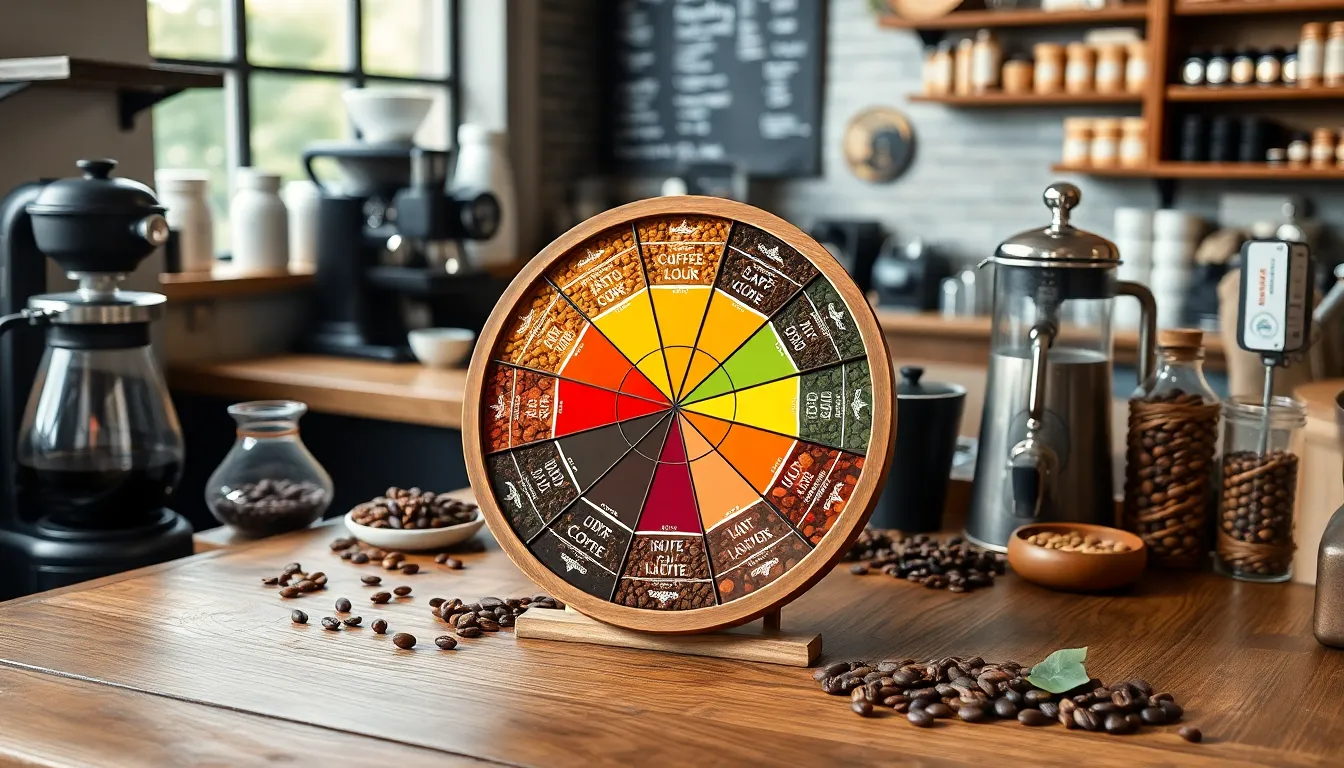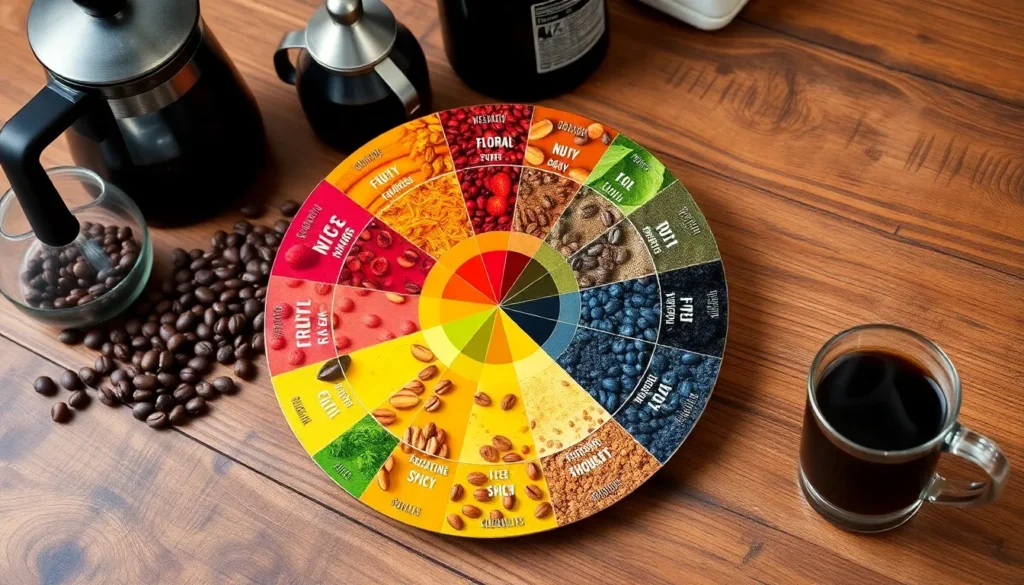Coffee lovers know that each cup can offer a unique experience. The coffee flavor wheel is a powerful tool that helps enthusiasts and professionals alike identify and describe the diverse range of flavors found in coffee. From fruity and floral notes to earthy and nutty undertones, this visual guide unlocks the complex world of coffee tasting.
Understanding the flavor wheel not only enhances one’s appreciation for coffee but also elevates the brewing experience. It invites drinkers to explore new profiles and discover their personal preferences. Whether you’re a casual sipper or a seasoned barista, mastering the coffee flavor wheel can transform the way you enjoy this beloved beverage.
Table of Contents
ToggleOverview of Coffee Flavor Wheel
The coffee flavor wheel categorizes flavors and aromas found in coffee, offering a comprehensive visual guide. This wheel delineates distinct flavor groups, including fruity, floral, and nutty notes, along with more complex characteristics such as chocolate or spice.
The central concept revolves around identifying unique flavor compounds contributing to coffee’s overall taste profile. By utilizing the flavor wheel, enthusiasts and professionals can effectively communicate tasting experiences, enhancing discussions regarding coffee quality and preferences.
Each section of the wheel represents specific sensory attributes. For example:
- Fruity: Berries, citrus, and stone fruits.
- Floral: Jasmine, lavender, and rose.
- Nutty: Almonds, walnuts, and peanuts.
- Spicy: Cinnamon, pepper, and clove.
- Chocolatey: Dark chocolate, cocoa, and milk chocolate.
Utilizing the coffee flavor wheel encourages exploration and experimentation with different brewing methods and bean origins, allowing drinkers to make informed choices about their coffee. Mastering this tool aids in understanding individual palate preferences and refining tasting skills.
Importance of the Coffee Flavor Wheel

The coffee flavor wheel plays a crucial role in deepening the understanding of coffee’s diverse taste profiles and enhancing tasting skills. This tool is essential for anyone looking to elevate their coffee experience.
Understanding Coffee Taste Profiles
Understanding coffee taste profiles is fundamental for appreciating the complexity of coffee. The flavor wheel categorizes flavors into groups like fruity, floral, nutty, spicy, and chocolatey. Each category provides essential insights into the sensory attributes of coffee. By referring to the wheel, drinkers discern subtle notes, promoting informed choices about brewing methods and bean origins. Enthusiasts can connect specific flavors to different regions and processing techniques, fostering a deeper appreciation of each coffee’s uniqueness.
Enhancing Coffee Tasting Skills
Enhancing coffee tasting skills occurs through regular practice and application of the flavor wheel. The wheel serves as a training guide, helping individuals articulate their sensory experiences. By systematically exploring different flavors and aromas, drinkers refine their ability to identify specific attributes in various coffees. Tasting sessions can become more insightful when equipped with the wheel, allowing participants to compare and contrast flavors effectively. This practice not only boosts confidence but also fosters a community of knowledgeable coffee lovers who can share experiences and recommendations based on detailed flavor profiles.
Components of the Coffee Flavor Wheel
The coffee flavor wheel consists of primary flavor categories and secondary flavor notes that collectively offer a comprehensive framework for tasting coffee. Understanding these components enhances the ability to articulate and appreciate coffee’s diverse flavor profiles.
Primary Flavor Categories
Primary flavor categories form the foundation of the coffee flavor wheel. These categories include:
- Fruity: This category encapsulates flavors reminiscent of various fruits, such as berries, citrus, and tropical fruits, which contribute to bright and refreshing tasting notes.
- Floral: Floral flavors bring delicate, aromatic qualities to coffee, often resembling jasmine, rose, or lavender, enhancing the complexity and fragrance of the brew.
- Nutty: Nutty flavors provide a richness to coffee, often presenting notes similar to almonds, hazelnuts, or peanuts, adding depth and warmth to the overall experience.
- Spicy: Spicy categories introduce flavors like cinnamon, clove, or black pepper, offering an intriguing contrast and enhancing the tasting profile with warmth and complexity.
- Chocolatey: Chocolatey flavors evoke sweet, rich notes of dark or milk chocolate, adding a luxurious element to the coffee experience, often found in various roasts.
Secondary Flavor Notes
Secondary flavor notes further refine the tasting experience by providing more specific descriptors within primary categories. Examples include:
- Citrus: Tasting notes might include lemon, lime, or orange, which complement fruity flavors and bring brightness to the cup.
- Dried Fruit: Notes such as raisin, fig, or prune can manifest in certain coffees, adding a concentrated sweetness and richness.
- Herbal: Herbal flavors, like mint or basil, are often subtle but can significantly influence the overall impression, offering freshness and complexity.
- Savory: Savory notes, including umami richness like that of peanuts or lentils, add depth, particularly in darker roasts.
- Toasty: Toasty flavors can evoke the essence of caramelized sugar or toasted bread, contributing to warmth and richness in the coffee.
By recognizing and articulating these primary and secondary flavor components, coffee enthusiasts and professionals can deepen their appreciation of coffee and improve their tasting skills.
How to Use the Coffee Flavor Wheel
Using the coffee flavor wheel effectively enhances tasting experiences and deepens the understanding of coffee’s complexities. Several techniques can aid in mastering its use, ensuring greater appreciation for different flavor profiles.
Tasting Techniques
Developing tasting techniques involves practicing specific methods to identify flavors accurately. He or she can follow these steps:
- Prepare the Coffee: Brew coffee using preferred methods, focusing on the right grind size and water temperature for optimal extraction.
- Observe the Aroma: Inhale deeply before tasting to detect distinct aromas, which contribute to the overall flavor experience.
- Taste Mindfully: Take small sips, allowing the coffee to coat the palate. Notice the initial, mid, and aftertaste to identify flavors effectively.
- Refer to the Wheel: Use the coffee flavor wheel during tasting to pinpoint specific flavors and aromas. Cross-reference detected notes with the appropriate sections of the wheel.
- Jot Down Observations: Document the tasting notes for each coffee, noting flavors experienced. This practice improves one’s ability to recognize and articulate flavors over time.
Pairing Coffee with Food
- Match Intensity: Select foods that match the coffee’s flavor intensity. Strong coffees pair well with richer, more robust dishes, while lighter coffees complement delicate flavors.
- Explore Flavor Harmony: Identify complementary flavors that enhance both coffee and food. For example, fruity coffees work well with desserts like pastries or fruit tarts.
- Balance Acidity and Sweetness: Pair coffee with foods that balance acidity. For instance, a bright, acidic coffee pairs nicely with creamy cheeses, while smooth, sweet coffees can complement chocolate desserts.
- Experiment with Contrast: Use contrasting flavors to create exciting pairings. A bold, dark roast may contrast pleasantly with savory biscuits or spicy dishes.
- Refine Personal Preferences: Continually experiment with different combinations to discover personal favorites. Documenting pairings can lead to a better understanding of how flavors interact.
Conclusion
The coffee flavor wheel serves as an essential guide for anyone looking to deepen their appreciation of coffee. By understanding its various flavor profiles and categories, drinkers can enhance their tasting experiences and develop a more refined palate. Mastering the wheel not only elevates personal enjoyment but also fosters connections with fellow coffee enthusiasts.
Through regular practice and exploration of different brewing methods and flavor pairings, individuals can unlock a world of coffee complexity. As they articulate their tasting notes and preferences, they contribute to a vibrant community passionate about sharing their coffee journeys. Embracing the coffee flavor wheel is a step toward becoming a more knowledgeable and confident coffee lover.





